The moment we started planning our trip to Piedmont and the land of Barolo and Barbaresco, I got butterflies in my stomach. I have long been a fan of this old world wine region. The reds of Barolo and Barbaresco are some of the best in the world and some of the few that find themselves aging in my cellar. Barbera is the staple red of this region and one of the best food wines you will find, with its nice balance of acidity, fruit and earthiness. Dolcetto is also in abundance with Arneis being the most common white wine you will find there.
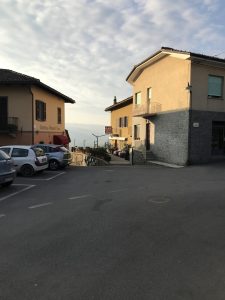
Castiglione Falletto
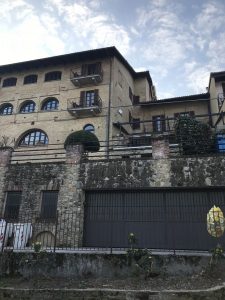
The plan was to visit three wineries while we stayed in Castiglione Falletto, an appellation in the Barolo region with a quaint little village and of course, a tower! Our first winery visit was Vietti.
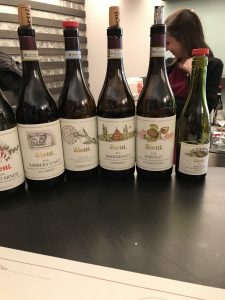
Tasting The Wines of Vietti with Emanuela
Emanuela guided us through the winery of Vietti with her impressive knowledge of the wine region and wine in general. Vietti, like most wineries in the Barolo and Barbaresco region, started off small. Now, with the popularity of the wines growing, Vietti found that their humble beginnings could not keep up with demand for their wines. They built a second winery down the hill from Castiglione Falletto to handle their mainstay wines and devoted the original winery to their vineyard designate Barolo and Barbaresco. Their cellar was impressive, made up of several floors dug underneath the winery. As they grew, they expanded underneath to try and keep up, finding this impossible, thus adding another facility.
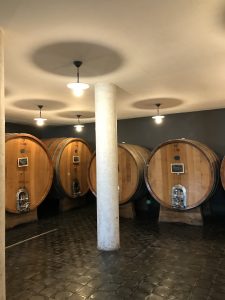
Just one of the many barrel rooms underneath the winery filled with puncheons.
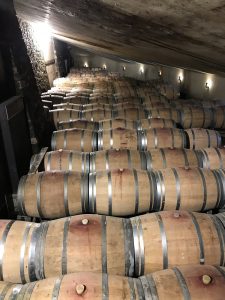
Running out of room!
It was quite interesting to listen to Emanuela discuss the techniques employed by the winemakers. Terms like “submerged cap” was a new one to me. During initial fermentation, a cap is formed on the fermenting grape juice which is either punched down to stir, or they pump from underneath the cap, over the top to break it up. Many wineries in the Barolo and Barbaresco region employ a tactic called submerged cap. At some point during the fermentation process, after punching down or pumping over, they allow the cap to form, then submerge it into the juice for a period of time. The submerged cap is meant to add complexity to the wine that simply punching down or pumping over will not achieve. Nebbiolo is a thick-skinned highly tannic grape but lacks color. Submerging the cap also gives the wine a little more color. Of course, this technique is only used on better vintages.
Another practice that is used throughout this region is the use of 5,000 to 5,500-liter puncheons. Most barrels used in both the new world and old world wine-making are 225-liter barrels or barriques, which is what most of us are familiar with. The larger oak puncheons used in Barolo and Barbaresco are generally used with Nebbiolo after they have been used for aging Barbera which benefits from new oak contact. After being used for a couple of years, they now use them to age Nebbiolo, the grape of both Barolo and Barbaresco. Emanuela explained to us that Nebbiolo, unlike other varietals, does not do well with new oak treatment. Because it is already high in tannins, the new oak just adds more tannins, making it austere and tight. Therefore, they like to age Nebbiolo in neutral puncheons, of which some are used for over 50 years! Why such large and expensive vessels to age the wines? Emanuela explained that they allow very little oxygen to reach the juice while it is aging which is critical since the wine is in barrel much longer than average. By the way, puncheons can run between $14,000 – $25,000 per unit depending on the size. That is a huge investment, and one of the reasons why both Barolo and Barbaresco tend to cost a little more at the store. However, compared to some wines they are a value.
After our tour, Emanuela opened a few bottles for me to taste. I was very impressed with all their wines including a dry and delicious Arneis (one of the best I’ve had), a Dolecetto, Barbera, “Perbacco” Nebbiolo, Barbaresco and Barolo. Keep your eyes open for the 2016 vintage out of Piedmont. The winemakers are very impressed with this vintage, saying it is the best of the millennium so far. The 2016 Vietti “Perbacco” Nebbiolo is proof of that. Excellent balance and integration of fruit, acidity and tannins. It will certainly age but is drinking fabulous now. Notes of strawberries, sour cherries, leather, tobacco and just a touch of rust with a solid backbone of red flowers and a long finish. I have long supported Vietti, and I was glad to have a chance to visit them.
The next day, Susie and I set off for Oddero, one of the oldest producers of Barolo and Barbaresco with their first bottling in 1878. That will be the subject in “The Land Of Piedmont” Part II.
Cheers!
Stan The Wine Man

